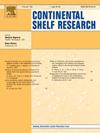Characterization of wave climate and trends for Alagoas State, NE Brazil
IF 2.2
3区 地球科学
Q2 OCEANOGRAPHY
引用次数: 0
Abstract
This study presents a spectral wave model developed and validated for the Alagoas State in NE Brazil using satellite altimeter data. The model, spanning 32 years from 1979 to 2010, driven by CFSR wind forcing, captures the wave climate dynamics across seasons and regions. Energetic waves dominate winter and spring, contrasting with milder conditions in summer. Spatially, heightened wave activity is concentrated in the southern border with Sergipe, notably near the São Francisco River mouth, gradually tapering off towards the northern coast. Trends in significant wave height (Hm0) reveal seasonal fluctuations, with winter and spring exhibiting positive trends, while summer trends are predominantly negative. Notably, winter trends peak at 0.6% per year along the central to southern coastal stretch. Conversely, summer witnesses a maximum negative trend of 0.4% per year nearshore. Over the 32-year span, the annual mean shows a general negative trend (∼0.2% per year) across most of the study area, albeit with minor positive trends in the northern region. Particularly noteworthy is the accelerated increase (∼0.4% per year) in extreme conditions (P99) nearshore where Hm0 reached 2.7 m on Maceió coast potentially exacerbating erosion and should be the object of further considerations for coastal management design.
巴西东北部阿拉戈斯州波浪气候特征和趋势
本研究提出了利用卫星高度计数据为巴西东北部阿拉戈斯州开发并验证的光谱波模型。该模型在CFSR风强迫的驱动下,跨越1979年至2010年的32年,捕捉了不同季节和地区的波浪气候动力学。冬季和春季主要是高能波,而夏季则较为温和。从空间上看,波浪活动的增强集中在与Sergipe接壤的南部边界,特别是在奥弗朗西斯科河口附近,向北部海岸逐渐减弱。显著波高(Hm0)趋势呈现季节性波动,冬季和春季为正趋势,而夏季主要为负趋势。值得注意的是,冬季趋势在中部至南部沿海地区达到每年0.6%的峰值。相反,夏季近岸的负趋势最大为每年0.4%。在32年的跨度中,尽管北部地区有轻微的正趋势,但大部分研究区域的年平均值总体呈负趋势(每年~ 0.2%)。特别值得注意的是,在极端条件下(P99)近岸的加速增长(每年约0.4%),Maceió海岸的Hm0达到2.7米,可能加剧侵蚀,应该成为海岸管理设计的进一步考虑对象。
本文章由计算机程序翻译,如有差异,请以英文原文为准。
求助全文
约1分钟内获得全文
求助全文
来源期刊

Continental Shelf Research
地学-海洋学
CiteScore
4.30
自引率
4.30%
发文量
136
审稿时长
6.1 months
期刊介绍:
Continental Shelf Research publishes articles dealing with the biological, chemical, geological and physical oceanography of the shallow marine environment, from coastal and estuarine waters out to the shelf break. The continental shelf is a critical environment within the land-ocean continuum, and many processes, functions and problems in the continental shelf are driven by terrestrial inputs transported through the rivers and estuaries to the coastal and continental shelf areas. Manuscripts that deal with these topics must make a clear link to the continental shelf. Examples of research areas include:
Physical sedimentology and geomorphology
Geochemistry of the coastal ocean (inorganic and organic)
Marine environment and anthropogenic effects
Interaction of physical dynamics with natural and manmade shoreline features
Benthic, phytoplankton and zooplankton ecology
Coastal water and sediment quality, and ecosystem health
Benthic-pelagic coupling (physical and biogeochemical)
Interactions between physical dynamics (waves, currents, mixing, etc.) and biogeochemical cycles
Estuarine, coastal and shelf sea modelling and process studies.
 求助内容:
求助内容: 应助结果提醒方式:
应助结果提醒方式:


